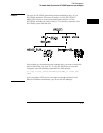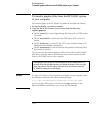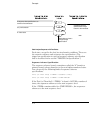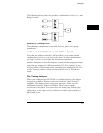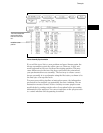
Sequence-Else Specification
The sequence-else branch, sometimes called the “else if” branch or
secondary branch, may branch to any other state, including the
current state, a previous state, or a later state. The sequence-else
specification looks like the following:
Else on "<TERM>" go to level <sequence level>
If the Sequence-Else specification is satisfied before the
sequence-advance specification is satisfied, the sequencer begins at
<sequence level>.
The last state may only have a sequence-else branch specification,
which may branch to the same state or a prior state.
Storage Specification
In each state, a storage specification determines the data stored by
the analyzer while it is searching for the sequence-advance,
sequence-else, and trigger specifications. Storage specifications are
defined using the same pattern, range, and timer resources available
for defining branching specifications.
While storing "anystate", "no state", or "<TERM>"
Note that if you specify “no state,” the analyzer still stores
sequence-advance terms and TRIGGER terms.
TRIGGER On Specification
If there are branch and storage specifications for each sequence level,
what does the trigger term mean? The trigger term is a special
sequence-advance specification in that, when found, it locks the
contents of analyzer acquisition memory. The trigger can be
positioned at the beginning, middle, or end of acquisition memory.
The trigger specification can look like the following:
TRIGGER on "<TERM>" <OCCURS> times
TRIGGER on "<TERM>" <TIME PERIOD>
If the trigger term is found <OCCURS> times, or if the trigger term
remains stable for <TIME PERIOD>, the trigger is captured in
memory. Then the sequencer advances to the next sequence level. If
Concepts
4–5





